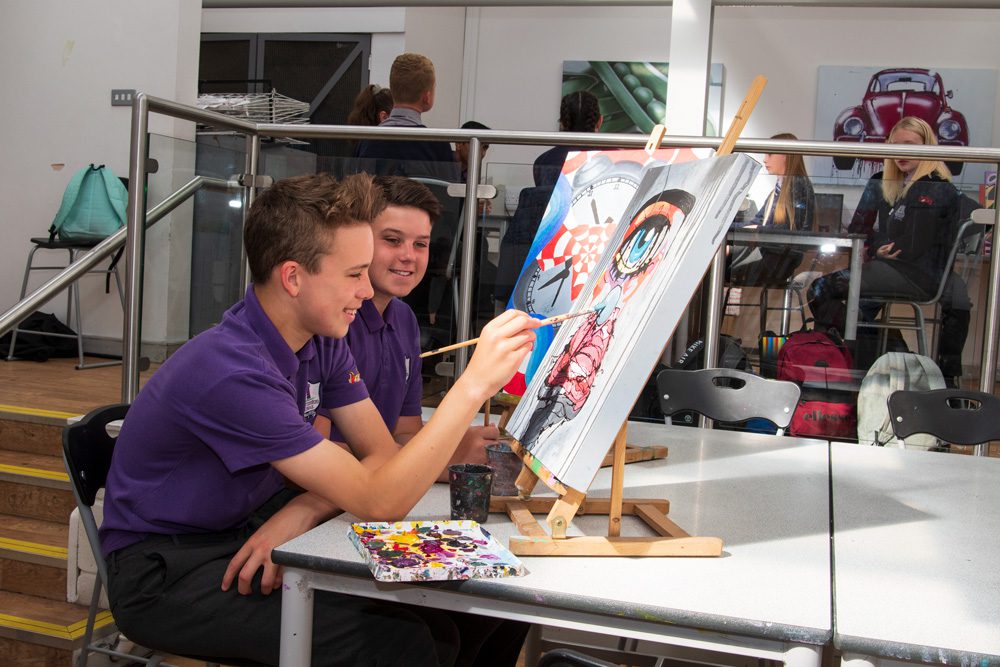

Welcome to the Art Department.
In Art lessons we want students to love drawing. We want students to take a moment out of a busy day and practise the joy of seeing, observing the things we so easily pass over. Not only do we want students to learn to draw, we also want students to draw to learn. This is because the act of drawing is valuable in helping us to make sense of the world around us and within us. One of our favourite quotes in the Art Department is from the artist Pablo Picasso who said
“Learn the rules like a pro, so you can break them like an artist”.
Our aim then is to give students the tools they need to create amazing works of art as well as the visual vocabulary to break their ideas apart and put them back together in new and inventive ways.
Key Stage 3 students cover a whole range of skills and techniques in readiness for their GCSE studies. Students begin by exploring the building blocks of Art, these are known as the Formal Elements and the Principles of Design. Students then build upon this knowledge and extend their skills as they move from year 7 into year 8 and then year 9. All students are introduced to a variety of Art practitioners from diverse backgrounds so they can develop their skills of analysis and take inspiration from some of the artworks investigated.
Year 7 students explore the basics of drawing in the autumn term, landscape painting, architecture and colour theory in the spring term and character design and animation in the summer term.
Year 8 students explore portraiture in the autumn term, careers in the creative industries in the spring term and abstract architecture in the summer term.
Year 9 students explore painting techniques and landscape painting in the autumn term, GCSE assessment objectives in the spring term and the history of art in the summer term.
Every lesson is designed to provide students with the tools, techniques and time they need to become proficient artists.
KS4
Key stage 4 students explore, develop and master their skills at meeting the four assessment objectives which are as follows:
AO1 – Investigating artists, cultures and contexts
AO2 – Experimenting with media and developing ideas
AO3 – Recording intentions through drawing, photography and research
AO4 – Presenting ideas and creating a personal and meaningful response to a given theme
Each one of these objectives is worth 25% of the overall marks for each project.
Students undergo three projects. The first two projects combined make up the student’s portfolio. This portfolio is worth 60% of a student’s overall grade. The third project is called an externally set task. This is set by the exam board AQA. Students are given a selection of themes or starting points. Students choose one of these themes and create a body of work in response to the theme using the knowledge and skills they have acquired over the 5 years. Students then undergo a 10 hour controlled assessment where they create a final response using the body of work they have already created whilst in exam conditions. This body of work and the final response make up the other 40% of a student’s overall grade.
How we assess
Students are assessed in both KS3 and KS4 on their skill at meeting the four GCSE assessment objectives. This gives students a much clearer idea of the expectations placed upon them at GCSE level whilst helping them to become fully rounded and confident artists.
Subject specific websites to support independent learning and revision
https://www.theartstory.org/
https://www.tate.org.uk/kids
https://artsandculture.google.com/
https://www.tate.org.uk/art/art-terms
https://www.artrabbit.com/
https://www.thisiscolossal.com/
Trips & Visits
All KS3 students will visit a local gallery and will have the experience of seeing famous artworks first hand.
A selection of students will work with an artist in residence.
KS4 students will visit a museum/art gallery in either Oxford, Liverpool or London so as to gain valuable experience and to record a range of ideas to be used for their portfolio.
Non- Required Work
There are a number of options for non required work in Art. You can look at the Big Picture in your Art Portfolio for ideas on places to visit, books to read and films to watch. There are activity ideas on each of the Knowledge Organisers found in the Art Curriculum area on the school website. Finally see the attached document for further ideas on how to extend your skills in Art. Enjoy!
Knowledge Organisers
By developing our visual communication and practical skills we also reap other benefits such as better mental health, increase in memory, the release of stress, emotional intelligence and improved co-ordination.